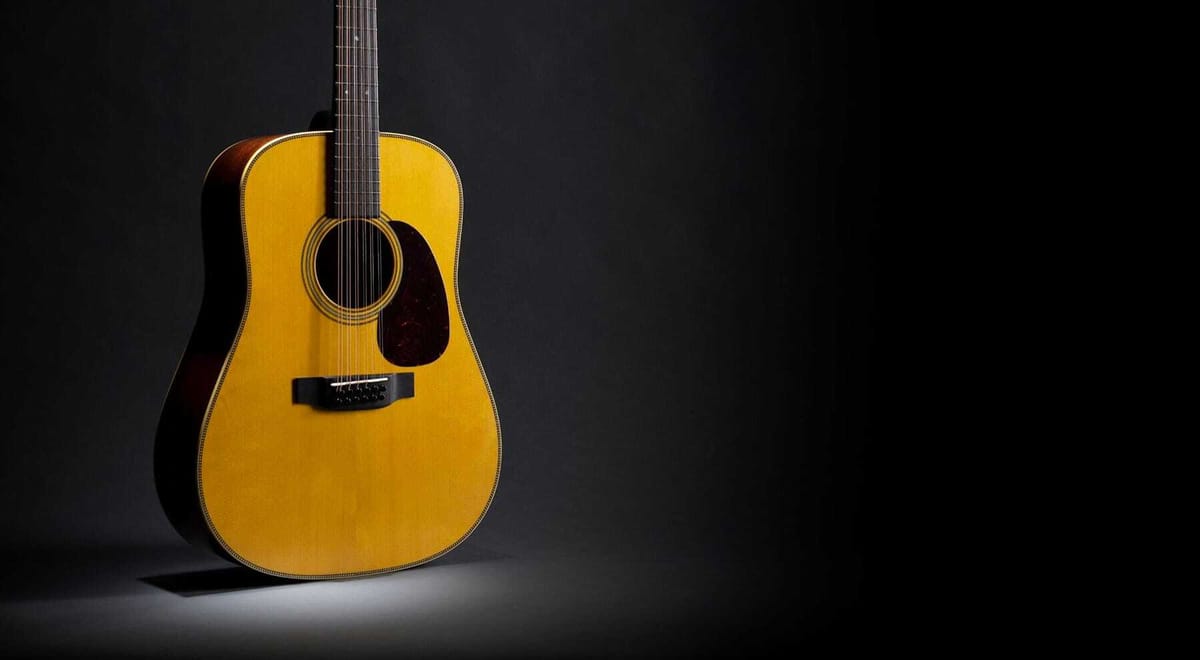How To Tune A 12-String Guitar? (Different Tunings Explained)

Are you fascinated by the shimmery and full sound of a 12-string guitar? Don’t let those extra strings hold you back!
Tuning might initially seem complicated, but it’s surprisingly similar to tuning a regular 6-string guitar, with just a few key differences. Whether you’re a seasoned musician or a beginner, this guide is your key to unlocking the tonal potential of your 12-string.
| The difference between a 6-string and a 12-string guitar lies primarily in the number of strings and the tuning. While the standard tuning for a 6-string guitar is E A D G B E, the 12-string guitar follows a similar tuning pattern. |
Despite its additional strings, tuning a 12-string guitar can be simplified by initially disregarding its extra strings and approaching it with the familiar method used for a 6-string guitar.
So let’s break down standard, open, and other various tunings you can use. Additionally, you can also use handy guitar tuners and resources to make the tuning process smooth and easy.
Grab your 12-string beauty and let’s demystify tuning a 12-string guitar together!
Different Tunings For A 12-String Guitar (Explained With Notes)
You can tune your 12-string guitar in many ways to carve the sound you want precisely. Here are some of the various tunes you can opt for.
Standard Tuning
When tuning a 12-string guitar, simplifying the process by adjusting the strings in pairs of 6 makes it significantly easier. Contrary to common belief, this method is straightforward.
- Begin by tuning the six standard strings to E A D G B E, then
- Adjust their thinner counterparts.
- Each paired string is tuned an octave higher than its dominant string (except for the last two pairs (B and E), which are tuned the same as their counterparts rather than an octave higher)
Semitone Tuning
Semitone Tuning involves adjusting the pitch of all 12 strings either up or down by one whole step, half a step, or even more.
An octave, also known as a semitone, represents a one-step change in pitch from its original tuning.
While most semitone tunings involve lowering the pitch from the standard tuning, there are also higher variations, although they pose a risk of string breakage.
A popular semitone tuning is E flat (Eb), where half a step tunes all strings down.
Drop D Tuning
Despite its popularity and simplicity on a 6-string guitar, Drop D tuning can be easily achieved on a 12-string guitar.
Unlike semitone tunings, Drop D is considered an alternate tuning. On a standard 6-string guitar, Drop D tuning involves lowering the lower E string a whole step while leaving the other strings unchanged.
Similarly, on a 12-string guitar, the thinner e-string is also tuned down a whole step to D, maintaining an octave higher than the standard D on top.
Open G Tuning
Open G tuning offers a rich and complex alternative to standard tuning. This tuning is particularly favored by renowned guitarists for its ability to create a G major chord when strumming openly. When applied to a 12-string guitar, this tuning elevates its melodic potential significantly.
In Open G tuning, the strings are tuned to D G D G B D.
The first four secondary strings are tuned an octave higher, while the last two remain unchanged. This configuration facilitates slide guitar techniques. It also provides a unique harmonic palette for expressive and emotional compositions.
The resonance of the 12-string guitar combined with Open G tuning produces a distinctive sound. This pattern is often associated with blues, folk, and rock music. Musicians find new routes for creative exploration and experimentation with dynamic and tonal ranges.
Open E Tuning
Open E tuning offers a vibrant tone by adjusting the strings to form an E major chord when played openly. Tuned to E B E G# B E (with G# denoting G sharp), this configuration capitalizes on the 12-string guitar’s resonance. This pattern enhances the robustness of the E major chord with synchronized or octave resonances across string pairs.
Ideal for slide guitar techniques, Open E tuning presents a compelling sound spectrum, particularly suited for blues music. The increased string tension enables dynamic responsiveness, enabling musicians to explore expressive nuances extensively.
Tuning a 12-string guitar to Open E unlocks many creative possibilities, providing a clear, energetic sound reminiscent of vibrant brightness and liveliness.
This tuning elevates the guitar’s sound quality, encouraging musicians to experiment with innovative sounds and melodies.
Open C Tuning
Simply put, tuning a 12-string guitar to Open C involves adjusting the strings to form a C major chord when strumming openly.
This tuning makes the guitar sound spacious, offering extended opportunities for creativity due to its unique tone.
Musicians can utilize Open C tuning to craft new melodies and compositions with a calming and rejuvenating quality.
Open C tuning encourages players to experiment with various sounds and musical ideas. With strings tuned to C, E, G, C, E, and G, it provides a straightforward yet effective platform for exploring chord progressions and crafting distinctive harmonies.
Open D Tuning
Tuning a 12-string guitar into Open D tuning involves adjusting the strings to create a D major chord when strumming openly.
This tuning is popular among slide guitar players, whether acoustic or electric. Open D offers versatility and a unique musical experience.
Tuned to D A D F# A D, the strings produce a warm and resonant tone, significantly altering the guitar’s sound. Open D tuning is accessible to musicians of all skill levels and is favored for its flexibility across genres, notably in blues rock and related styles.
Tune Your 12-String Guitar With A Tuner
Tuning your 12-string guitar with a tuner is both easy and popular. Attach the tuner to your instrument, play each string individually, and adjust accordingly.
Here are two types of guitar tuners that you can consider investing in!
1. Electronic Tuners
Electronic tuners are the simplest to use, as they detect all the notes you play. Chromatic tuners are particularly useful for tuning a 12-string guitar.
They provide accurate readings as you adjust your strings’ tension. They make it easier to achieve the correct pitch for each string pair.
2. Automatic Tuners
Automatic tuners are basically mechanical devices. These tuners detect the pitch of your string and adjust the tuning peg for you, making tuning incredibly convenient.
Automatic tuners do all the work for you. The most amazing part would be the automatic tuning feature. It tunes each string in your desired tuning type, whether standard, open, drop, or other alternate tunings.
With features like signal indicators, such as vibration or flashing lights, automatic tuners ensure precise tuning without the risk of over-tightening or breaking strings.
This method saves time and effort, especially for freshly installed strings. Get rid of the strain on your wrists and hands associated with manual tuning.
Use Tuner Apps
Tuner apps offer a convenient alternative for tuning your 12-string guitar. There are many dedicated guitar tuner apps accommodating various types of guitars, including twelve strings.
Some apps even feature a specific mode for tuning 12-string guitars, simplifying the process further. However, even a basic chromatic tuner app can effectively adjust your instrument, providing flexibility and accessibility for guitarists of all levels.
So, What Tuning Are You Getting Into?
Tuning a 12-string guitar may seem daunting due to its doubled string count, but it’s not twice as difficult. Memorizing the standard tuning – eE aA dD gG BB EE – and using the right tools simplify the process. A clip-on tuner or chromatic tuner app is ideal for achieving precise tuning without hassle. With these tools and knowledge, tuning a 12-string guitar becomes straightforward and accessible to all musicians.





